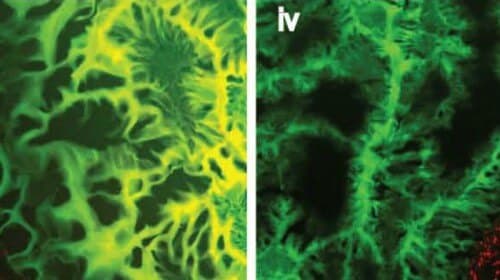Breakthrough: Patient-tailored biomaterials

Modern medicine still does not know how to deal with all intestinal diseases. Unfortunately, in a series of diseases such as Crohn's, colitis and various inflammations, as well as intestinal cancer, the solution that medicine offers today is to resect part of the intestine. What is even more unfortunate is that in about 30% of patients who undergo such surgery, there is a leak through the scars of the surgery afterwards, which can cause severe intestinal infections, great suffering for the patients and even the risk of death. Many researchers are trying to solve the problem using biological adhesives. These are substances that are usually based on protein, or on other chemical compounds that exist in nature, and are used to fuse wounds, stop bleeding and improve recovery from difficult surgeries. However, the biological adhesives proposed for intestinal surgeries are still not close to the expected level of efficiency, and the researchers have not yet come up with a material that both adheres well to biological tissues, and is also suitable for the chemical environment of the intestine (and is, of course, non-toxic).
environmental effect
A team of scientists led by female researchers from the Massachusetts Institute of Technology (MIT) and Harvard Medical School approached the problem of intestinal adhesions from a new angle. The researchers developed a new glue, based on uniquely ordered nitrogen compounds known as dendrimer (dendrimer, from the Greek word dendron - tree), and combined with a sugar called dextran. [For those who are interested - a short explanation of the adhesive composition at the bottom of the list]. However, the researchers led by Prof. Nathalie Artzi, were not satisfied with the actual development of the adhesive. They understood that the environment in the intestines is not the same for every person with a medical condition, and believed that adapting the glue to the environment could greatly improve the chances of its successful use. To test the hypothesis, they tested the effectiveness of different compositions of the glue, in two different environments: in animals suffering from intestinal cancer, and in animals suffering from colitis - a severe chronic inflammation of the intestine. The study, published this week in the journal Science Translational Medicine, they report that real differences were indeed found in the chemical composition of the intestinal environment. In the animals with colitis (in this case rabbits), there was a sharp decrease in the level of collagen in the intestine (collagen is a protein that plays an important role in the formation of the tissue skeleton, which connects the cells), and as a result, there were much fewer adhesive binding sites in the intestine. As a result, the adhesion efficiency of the "standard" material decreased by 50% or more. In contrast, in the cancerous intestine (in this case in rats), there is more collagen than in a healthy intestine, which makes it possible to use less glue, and change its concentration accordingly. The research team developed a mathematical formula that makes it possible to adjust the composition of the glue to the level of collagen in the intestine (more precisely, to the concentration of amine groups, simple nitrogen compounds present in collagen, which are the site of attachment to the glue), and indeed succeeded in upgrading the level of effectiveness of the glue in experiments on laboratory animals. "The idea will be to take a biopsy from the patient during surgery, characterize the tissue, understand the severity of the disease, and then - using the formula we developed - choose the composition of the material that will lead to the best results for the patient," explains Prof. Artzi.

fast track
The successful development of Artzi and her colleagues has already passed the stage of pre-clinical experiments in animals - rats, mice and rabbits - and soon it should begin clinical experiments in humans. "Since this substance is classified as a medical device, and not as a drug, the FDA (American Food and Drug Administration) approval process should be relatively quick," she explains. "We hope that in a few years it will reach the clinic and help save patients." However, beyond the important development in itself, Artzi emphasizes that the main importance of the research is the paradigm shift. "The idea is to develop personalized materials for the patient. There is no longer one size fits all - something that is suitable for everyone. A substance will react differently with different tissues, in the face of a disease and depending on the severity of the disease, and these things must be taken into account when developing substances for medical use." Artzi further points out that it is not just biological adhesives, but any material that should enter the body: artificial implants, orthopedic screws, supports for catheterization, and other devices, and of course also technologies that are in the development stages such as tiny devices for bringing medicines to a precise location, or devices for monitoring the patient's condition. The era of personalized medicine is not only a science of genetics and molecular biology, it is also a science of materials, and their intelligent use - and adapted to the patient and his condition - may greatly improve the medical results.
The research was also led with Artzi by Nora Olivia and Maria Karakol, as well as two young researchers from Israel - Sivan Slickter and Margarita Beckerman - materials engineering students at Ort Brauda College in Karmiel, who are doing the internship in Artzi's laboratory in Boston, with the help of a scholarship program funded by Sami Segol.
Reliable glue
As promised for those interested: a brief explanation of the composition of the adhesive. A dendrimer is a special arrangement of molecules, in a form reminiscent of branches arranged in a circle. One of the common dendrimers in medical research, which was also used in this study, is called Polyamidoamine, or PAMAM for short. As its name suggests, it consists of amine groups and amide groups, both small molecules centered on a nitrogen atom, bound to oxygen (in amide) and usually also to hydrogen (in amine) and other substances.
To get the unique shape of the dendrimer, it is not enough to mix the ingredients, it must be done in a certain order and with a technique that allows the molecules the unique spatial arrangement, reminiscent of branches arranged in a circle. The other ingredient is dextran, which is a polysaccharide. A basic sugar molecule consists of six carbon atoms arranged as a ring (or hexagon), with each of them also bonded with oxygen and hydrogen atoms, in a composition that varies according to the type of sugar. Polysaccharides are polymers (long chains of rings). In the internal environment of the body, the dextran molecule is oxidized, and binds tightly to amine groups. As mentioned, such groups are found in the collagen that makes up the intestines, and also in the multi-branched dendrimer. The combination between the sugar chain that sticks tightly to the intestine on one side, and the multi-branched dendrimer on the other side, which binds the parts together, creates a strong and effective biological glue. This glue has another important property: it gradually decomposes (the rate of decomposition is also a property that the researchers can control in the production of the material), and disappears from the body after it finishes its function.
